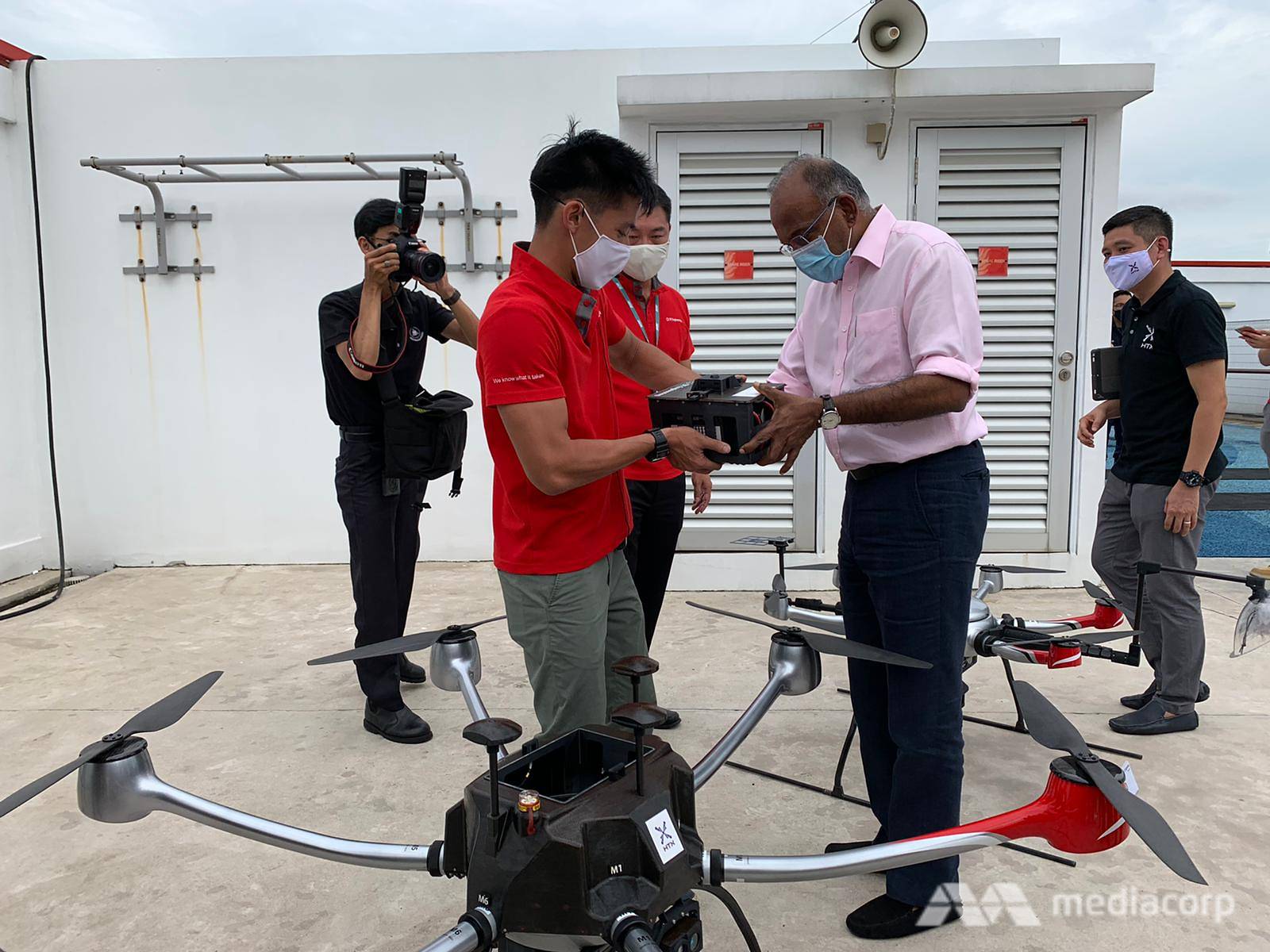SINGAPORE: A building collapses, leaving multiple casualties in cardiac arrest and in need of immediate medical attention.
Within minutes, drones carrying automated external defibrillators (AED) arrive at the scene, faster than any ambulance could ever get there.
This could soon become a reality after the Home Team Science and Technology Agency (HTX) said on Wednesday (Sep 16) that it is working with different Home Team departments to design and customise long-range, autonomous drones for specific needs and requirements.
These unmanned aerial vehicles (UAV) can automatically launch and recover vertically, as well as fly beyond an operator’s visual line of sight (BVLOS). On the ground, the drone’s batteries can be automatically replaced.
The drone being launched from the drone box. (Photo: Aqil Haziq Mahmud)
The drones, co-developed with ST Engineering, can be used during security operations in areas which may be inaccessible or where situations are too risky for manual operations, HTX said.
They can fly about 8km in 30 minutes, covering a longer distance and larger area in a single mission, HTX added.
The Singapore Police Force had announced in May that it will use similar drones to patrol industrial estates. Unlike the BVLOS drones, however, those drones must fly within a pilot’s line of sight and cannot be programmed to fly routine operations.
READ: Police to use autonomous drones to patrol industrial estates
HTX said in a statement on Wednesday that BVLOS drones can be used as a first responder to provide a situational picture of an incident. This includes high-security events with large crowds, as well as during sustained and routine patrols.
“As videos from the UAVs can be streamed to the Police Operations Command Centre, the police can rapidly view and assess the situation before deciding on the appropriate resources to send to the ground,” it said.
The drones can also play a “critical role” in the detection of hazardous materials, monitoring of fire scenes and delivery of essential supplies like medical equipment, HTX stated.
“(This) can include AEDs during critical missions like building collapses to help achieve a shorter response time for life-threatening cardiac arrest cases,” it added.
“The ability to commission BVLOS flights will increase the efficiency of Home Team operations and empower frontline officers to focus on higher-order tasks.”

Mr Shanmugam checking out the drone’s batteries that can be automatically replaced in a drone box. (Photo: Aqil Haziq Mahmud)
Home Affairs Minister K Shanmugam, who viewed a BVLOS UAV flight demonstration at Tuas View Fire Station on Wednesday, said the drone is a “very important additional capability”.
“It allows us to multiply the force without additional manpower and gives you a dimension which even manpower cannot give you,” he said.
“The use of technology is extremely important. Take SCDF for example, if you have a robot that can do firefighting, the benefits are pretty obvious. If you have robots which can fly and identify the areas that need to be dealt with, the benefits are obvious.”
Law and Home Affairs Minister K Shanmugam attended a flight demonstration of the drone. (Photo: Aqil Haziq Mahmud)
READ: Singapore police roll out drone-equipped surveillance vehicles
DRONE BOX CONCEPT
The BVLOS drone is operated using a Drone Box concept that can autonomously launch and recover it as well as change out deployed batteries, said Mr Cheng Wee Kiang, director of HTX’s Robotics, Automation and Unmanned Systems Centre of Expertise.
The box is a container on the ground that opens and closes automatically to launch and recover the drone, with robotic arms inside that change the equipment on the drone.
Operators tell the drone where to go and monitor footage from its cameras from a back end location.
“Within the Drone Box, there is also a batch of drone batteries that are being charged and ready to be installed,” he said.
“This feature allows for a quick turnaround during operations without the need for manual intervention.”
Mr Shanmugam watching footage from the drone. (Photo: Aqil Haziq Mahmud)
The drone also has an automatic payload swap feature that changes out the equipment it carries depending on the operation. The equipment includes cameras, hazardous material detectors or delivery mechanisms.
“The automated payload swap means that the payloads can be adapted to different missions and situations swiftly,” Mr Cheng said.
“Since the mundane and time-consuming tasks are taken care of by automation, it will tremendously improve the agility and efficiency of the Home Team’s operations.”
The police said they recently trialled the BVLOS UAV during an enforcement operation at an industrial estate in Tuas when it successfully led ground officers to a location where suspicious activities were taking place.
Assistant Superintendent of Police Benson Tong, a capability development officer at the Home Team UAV Team, said the drones introduced in May required pilots to be on the ground to maintain a line of sight.
“Whereas for BVLOS, our officers can operate the drone remotely elsewhere, therefore ensuring their safety,” he added.




